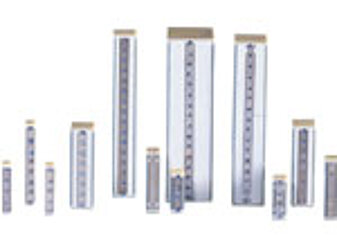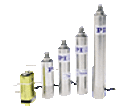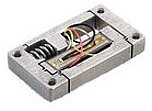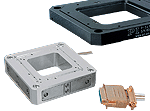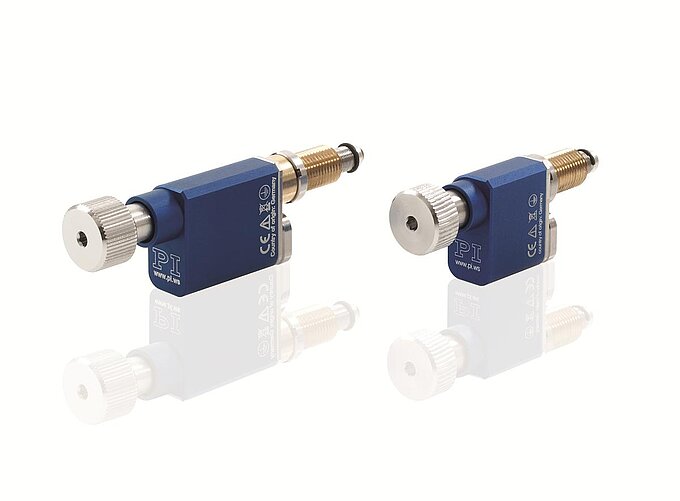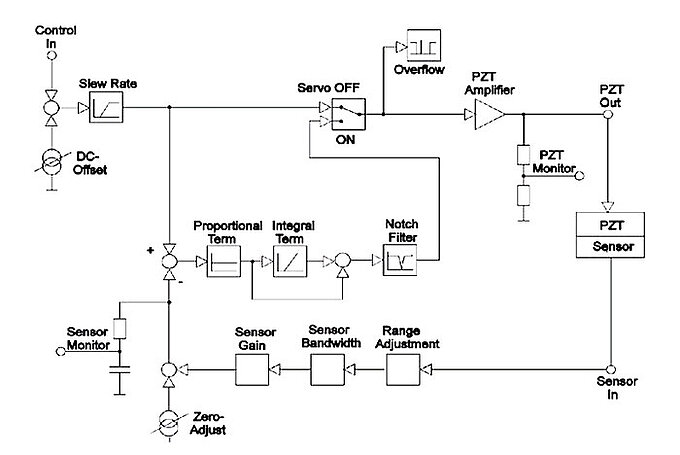Displacement of Piezo Actuators (Stack & Contraction Type)
Hysteresis (open loop PZTs)
Hysteresis can be eliminated by closed loop Piezo actuators. Similar to electromagnetic devices, open loop piezo actuators exhibit hysteresis (they are also referred to as ferroelectric actuators). Hysteresis is based on crystalline polarization effects and molecular friction. The absolute displacement generated by an open loop Piezo depends on the applied electric field and the piezo gain which is related to the remanent polarization. Since the remanent polarization and therefore the piezo gain is affected by the electric field applied to the piezo, its deflection depends on whether it was previously operated at a higher or a lower voltage (and some other effects). Hysteresis is typically on the order of 10 to 15 % of the commanded motion.
E.g. if the drive voltage of a 50 µm piezo actuator is changed by 10 %, (@ 5 µm motion) the position repeatability is still on the order of only 1 % full travel or better than 1 µm. Classical motor driven leadscrew positioners will hardly beat this repeatability.
PI closed loop piezo actuator systems eliminate hysteresis. PI offers these systems for applications requiring the absolute position information, as well as motion with high linearity, repeatability and accuracy in the nanometer and sub-nanometer range.
For positioning where the travel is controlled by an external servo loop (e.g. the eyes and hands of the operator or a sophisticated electronics system), hysteresis behavior and linearity are of secondary importance since they can be compensated for by the external loop.
Example:
Piezoelectrically driven fiber couplers derive the control signal from the optical power transmitted from one fiber to the other. The goal is to maximize the transmission rate, not to determine the exact position. An open loop Piezo system is sufficient for this application offering unlimited resolution, fast response, no backlash and no stick/slip effect.
For periodic motion, hysteresis does not affect repeatability.
Creep (Drift) (open loop PZTs)
For perodic motion, creep does not affect repeatability
Creep only occurs with open loop PZTs. Like hysteresis, creep is related to the effect of the applied voltage on the remanent polarization of the piezo ceramics. Creep decreases logarithmically with time. If the operating voltage of a (open loop) Piezo is increased (decreased), the remanent polarization (piezo gain) continues to increase (decrease), manifesting itself in a slow creep (positive or negative) after the voltage change is complete. The following equation describes the effect:
ΔL(t) » ΔL(1+g*lg*(t/0.1))
Creep of Piezo motion as a function of time.
where
ΔL = displacement 0.1 seconds after the voltage change is complete [m].
g= creep factor which is dependent on the properties of the actuator (on the order of 0.01 to 0.02).
Maximum creep (after a few hours) can add up to a few % of the commanded motion.
Aging
Aging refers to reduced piezo gain as a result of the depoling process. Aging can be an issue for sensor or charge generation applications (direct piezo effect), but with actuator applications it is negligible, because repoling occurs every time a higher electric field (in the poling direction) is applied to the element.
If you have any questions, ask a PI engineer for help.

